Results 1 to 10 of 10
-
05-03-2013, 10:26 PM #1Senior Member

- Join Date
- Apr 2012
- Location
- Jersey City
- Posts
- 225
Thanked: 50 Cardboard/Pressboard Replacement Scales?
Cardboard/Pressboard Replacement Scales?
A recent pick up off da bay was a Joseph Allen "Medium Size Hollow Ground" NON-XLL. I was interested in the scales as I hadn't seen a pattern like this. Upon arrival the condition of the blade was a pleasant surprise as it was in very good shape. Looks like a little quality time with a ballgame and some Mothers and it will be good to go to the stones.
Even more interesting was the scales. They were obviously replacements at some point in it's life. From the sale pictures I was expecting a hardened rubber as they didn't look plastic or celluloid. But not until I held them did I discover that they seem to be a form of pressboard or early cardboard. The diamond pattern is pretty defined and smooth but the edges reveal layers of a stiff material. They are light and a bit swayback so there isn't much lateral strength.
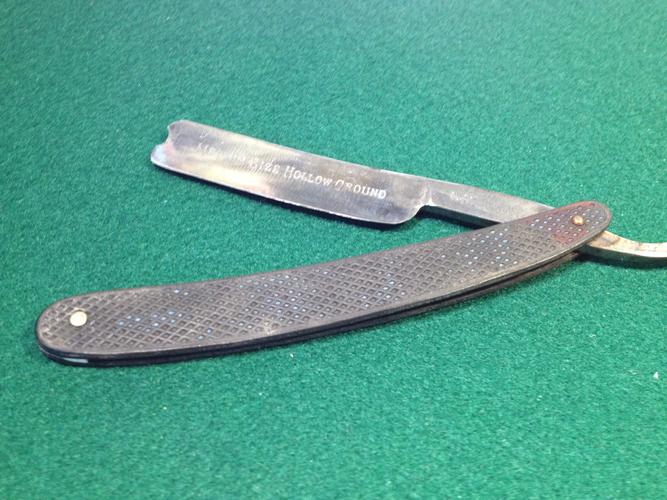
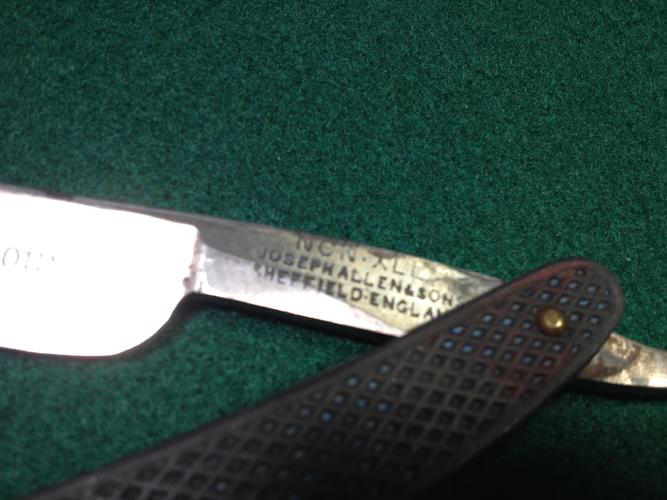
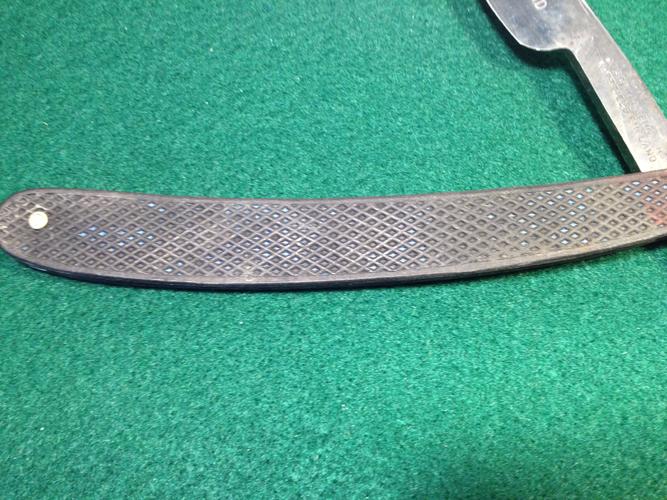
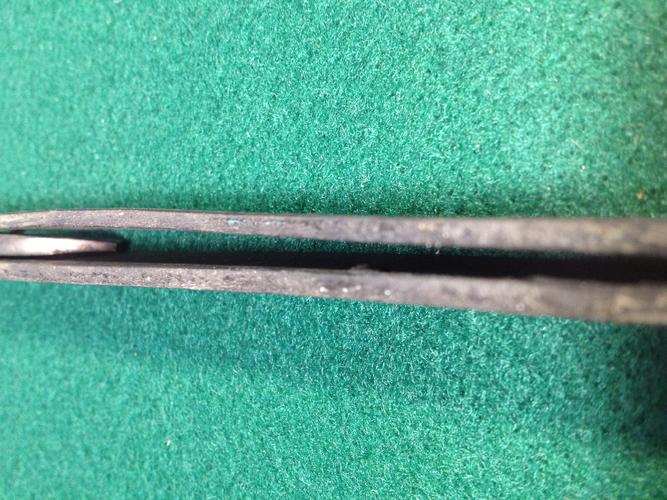
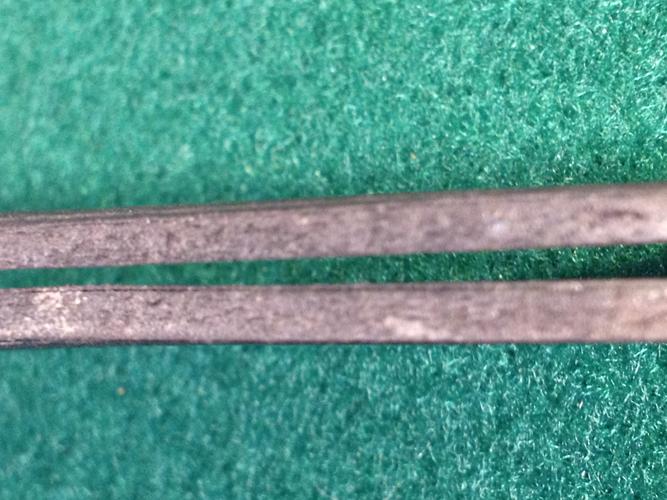
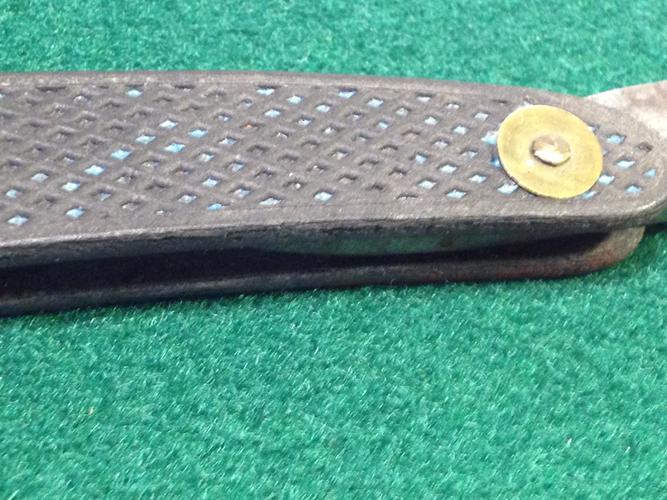
They have a nice surface feel to them but the weight is all off. Imagine a razor with foamcore scales, they are that light.
And no, I don't know what the blue stuff is.
Anybody know of a time period these were found in?Every gun that is made, every warship launched, every rocket fired, signifies in the final sense a theft from those who hunger and are not fed those who are cold and are not clothed. Dwight Eisenhower
-
05-03-2013, 11:03 PM #2

I bought the same model today at an antique store. I did a search on this site and found some older threads that discussed this razor. According to what I read, it appears your razor was made after 1890.
My razor has dark brown scales(appeared black at first glance) which I think are horn. I will probably be posting pictures this weekend to get opinions on whether it can be cleaned up for daily use, or whether the razor is more suitable to just practice honing.
-
05-04-2013, 01:49 AM #3At this point in time...




- Join Date
- Jun 2007
- Location
- North Idaho Redoubt
- Posts
- 27,032
- Blog Entries
- 1
Thanked: 13246
Over the years I have seen ONE with "Cardboard" scales they were coated with something, the razor had a hotel name so I assumed it was a promo razor, steel was fine..
I have had three sets of Leather scales cross my bench too
-
05-04-2013, 10:35 AM #4Senior Member



- Join Date
- Apr 2008
- Location
- Essex, UK
- Posts
- 3,816
Thanked: 3164
They look more like hardened, boiled leather scales to me - 'cuir bouilli' - quite common at one time for cheaper razors. I have a couple in that pattern
Regards,
Neil
-
The Following User Says Thank You to Neil Miller For This Useful Post:
lz6 (05-07-2013)
-
05-04-2013, 02:14 PM #5Senior Member

- Join Date
- Apr 2012
- Location
- Jersey City
- Posts
- 225
Thanked: 50
Thank you.
Two questions. First, what kind of time frame are you speaking of? Was it still being done in the early 20th century?
Second, what kind of weight are those scales? I would have thought that hardened leather would have some heft, along the line of bone scales but lighter than wood.Every gun that is made, every warship launched, every rocket fired, signifies in the final sense a theft from those who hunger and are not fed those who are cold and are not clothed. Dwight Eisenhower
-
05-04-2013, 05:47 PM #6Senior Member



- Join Date
- Apr 2008
- Location
- Essex, UK
- Posts
- 3,816
Thanked: 3164
I have some WW1 razors with the plain pressed leather scales - the centres are gently curved with a pressed rebate along the edges. They are recogniseable by the army service numbers pressed into the scales at a later date. I have a few from earlier razors too, so presumably they were quite common in the 1900s.
I also have a 1930s razor - dated from a newspaper ad of 1933 - that has those checkered leather scales. The pattern was pressed in, not cut. The leather scales were pressed while the leather was hot, hot enough to cause the tannin aggregates to flow so it becomes plastic and can take on any form or pattern. The leather was either hardened and pressed in sheets or macerated to a pulp. The cut edges look rougher than the surface, as if cut with a paper guillotine.
The checkered pattern was still to be ff
Ound in the 194os - it was popular for the scales on cheap knives, but it was even then being replaced with synthetics like plastic.
I suppose on of the reasons it remained popular for so long (it originated with body armour, after all) is that the maceration process made use of cheap off-cuts from the leather trade, in much the same way that bakelite used sawdust from woodmills before milling it to reduce it into wood flour and binding it with chemicals.
Regards,
NeilLast edited by Neil Miller; 05-04-2013 at 05:50 PM.
-
The Following User Says Thank You to Neil Miller For This Useful Post:
BobH (05-04-2013)
-
05-04-2013, 06:29 PM #7

I've got a Genco Pyramid 6N razor with what appears to be hardened leather scales. Originally, I thought they were cardboard or cheap celluloid, but I put the 45x loupe to the razor today and it looks a lot more like leather than anything else. There's a coarse wood grain pattern pressed into the scales.
These scales look cheap and feel flimsy and this razor has been in my restoration pipeline for some time. Now I'm in a quandary about whether these scales simply make this razor more distinctive and should be left alone.
-
05-04-2013, 10:03 PM #8Senior Member

- Join Date
- Apr 2012
- Location
- Jersey City
- Posts
- 225
Thanked: 50
Thanks Neil,
I honed the Non-XLL up and it's a sweet shaver. While the blade probably deserves a better presentation than it has currently, I'm going to leave the scales as is for now. Now it's a shaving tool that has an interesting history rather than being just pretty.
Might end up being like a parent that loves it's ugly child the most.Every gun that is made, every warship launched, every rocket fired, signifies in the final sense a theft from those who hunger and are not fed those who are cold and are not clothed. Dwight Eisenhower
-
05-04-2013, 10:52 PM #9

Believe that some scales were made from asbestos mixed with a resin. Not sure how you could tell?
-
05-04-2013, 11:40 PM #10Senior Member



- Join Date
- Apr 2008
- Location
- Essex, UK
- Posts
- 3,816
Thanked: 3164
Asbestos was a populr filler -a cheap bulkig material that added opacity. It was used a lot in celluloid scales that were not translucent, fo example.
The difference between resin, whether bulked out with asbestos or not and hardened leather - or even bakelite, vulcanite/hardened rubber, is pretty obvious.
You just have to use fingers, eyes and nose in most cases. A smell of vinegar or camphor or bunt rubber differentiates between celluloid/xylonite and vulcanite/hardened rubber, the degree of brittleness or plasticity helps with acrylics, resins and bakelite, filed ivory smells like the dentist drilling your teeth, filed horn smells like burnt hair, etc, etc,etc. You just have to learn the characteristics of each material - experience is how you tell.
Regards,
Neil


 4Likes
4Likes
 LinkBack URL
LinkBack URL About LinkBacks
About LinkBacks






 Reply With Quote
Reply With Quote

